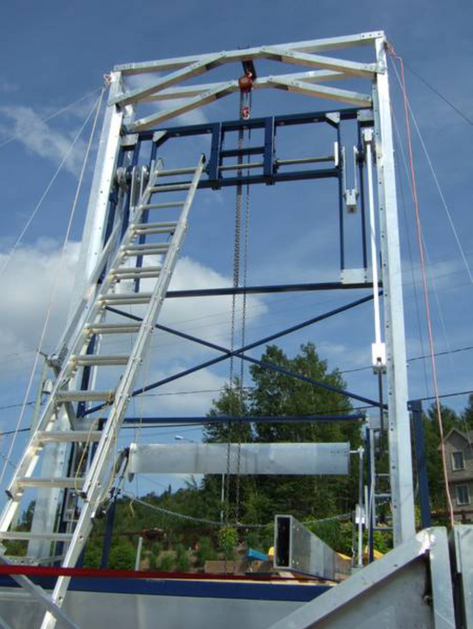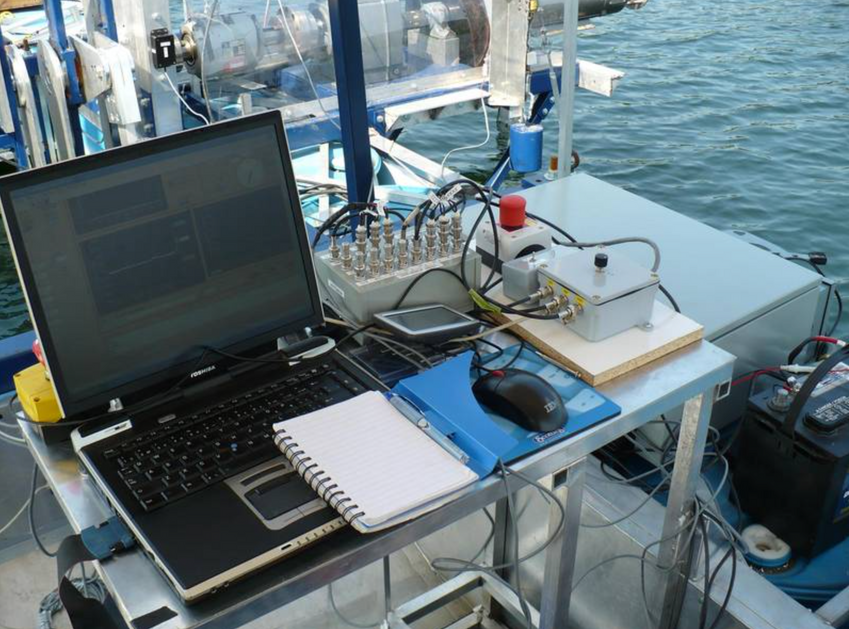%20(1)%201.png)
HAO 1
Objectives
The main purpose of the experimental campaign that has taken place during the summer of 2009 was to assert the energy extraction potential of the oscillating-wing turbine technology. This has been done via extensive measurements on a complete prototype in operation.
Numerous CFD simulations were performed over the last 4 years in order to optimize the oscillating-wing concept. Comparison of the CFD predictions with high quality field measurements should help validate and/or improve the numerical models.
The 3-year HAO-Laval project has culminated during the summer 2009 in a prototype testing campaign whose purpose was twofold:
1. To demonstrate and quantify the energy extraction potential of the oscillating-wing turbine concept;
2. To validate the computational fluid dynamics (CFD) modeling performed at the LMFN (Computational fluid dynamics laboratory).

Here are some characteristics of the experimental setup:
-
The oscillating-wings turbine is mounted to a lift in the central section of the pontoon. The lift allows to lower the turbine down to 2 meters under water level for operation, and to raise it out of water once the tests are done;
-
The boat is about 10 m long and massive (about 3000 kg) in order to remain stable on water even when the turbine is operating;
-
The turbine consists of two wings in a tandem configuration with each wing having a span of nearly 2 m.
-
An outboard motor drives the boat through water, allowing to reach speed up to 2 m/s;
-
The rated power of the prototype is 2 kW. The electricity produced helps recharge batteries or is dissipated through heating elements.
-
Water velocity probes are installed underwater in order to determine with accuracy the boat speed (which becomes the upcoming flow velocity with respect to the turbine) during each turbine test.
One of the challenges associated with such an experimental campaign is to find a proper test site. The latter must provide a flow quality suitable to a scientific experiment.
To ensure uniformity and control of the upcoming flow, it was decided to mount the oscillating-wings hydrokinetic turbine on a large, high inertia pontoon. This setup gives added flexibility on the choice of operating conditions compared to a river-based rig, although it is not the targeted application.
Our custom-made instrumented boat along with its oscillating-wings hydrokinetic turbine is shown below.
Experimental setup
The experimental setup includes probes and meters to determine at every instant the power extracted by the hydrokinetic turbine:
-
A torque meter is installed on the rotating shaft, allowing to measure torque on the turbine side, just before the gearbox and the generator.
-
A resolver is fixed at one end of the rotating shaft, measuring the rotating speed with high accuracy.
-
Accelerometers are used to assert the pontoon stability.
-
Water velocity probes are fixed underwater in order to measure precisely the boat speed.
These measurements are recorded synchronously many times per second on a laptop computer.
The power extracted is calculated with the product of the instantaneous torque and instantaneous rotating speed:
Power [Watts] = Torque [Newton-meters] x Rotation speed [radians/second]
The average power extracted can then be computed and compared to the available power in the water current, which is proportional to the cube of water flow velocity (the pontoon speed). One obtains the turbine power extraction efficiency as the ratio of the power extracted to the available power.

What is measured?
The experimental campaign HAO-Laval of the summer 2009 has been a resounding success.
Results from the field tests have been analyzed and confirm the great potential of the concept (see published articles in the Links section). The oscillating-wings hydrokinetic turbine technology is most certainly promising with recorded energy-extraction efficiencies over 40%.
The success of this first development phase of an oscillating-wing hydrokinetic turbine leads the way to the next step involving the deployment in a tidal stream of a second generation prototype of increased power.
Results overview from poster presented to the 4th INORE Symposium
Current status
Photo Gallery
Here are some pictures taken at different stages of the project HAO-Laval, and mostly during the experimental campaign which has taken place at Lac Beauport near Quebec City in the summer 2009:
Thanks
For their contribution to this innovative research project, the Project HAO team warmly thanks the following partners:
-
Le Fonds québécois de la recherche sur la nature et les technologies (FQRNT
-
Le Conseil de recherches en sciences naturelles et en génie du Canada (CRSNG)
-
La Municipalité de Lac-Beauport
-
Mrs Hélène Renaud, Director
-
Mrs Nathalie Fournier, Environment project manager
-
Mrs Marie-Élaine Boivin, Nautical Club manager
-
Mr Mathieu Durette, Environment assistant project manager
-
-
La Société de Valorisation des Applications de la Recherche (SOVAR)
-
Mr Luc Potvin, Ph.D.
Scientific advisor -
Mr Yves Matte, P.Eng. M.Sc.
Director of Physical, Engineering and Information technologies
-
Atelier de génie mécanique de l'Université Laval
Jonathan Talbot
Jean-Claude Gariépy
Pierre Carrier
Frédéric Morin
Le laboratoire de machines hydrauliques
Mme Claire Deschênes, ing., Ph.D., directrice
M. Richard Fraser, ing., professionnel de recherche
Anciens étudiants et collègues
Annick D'Auteuil
Pierre-Luc Delagrave
Jérôme Deschamps
Jean-Frédéric Faure
Mathieu Olivier
Maxime Jutras
Steve Julien
Project HAO team
Laboratoire de mécanique des fluides numérique (Computational Fluid Dynamics Laboratory)
Guy Dumas
guy.dumas@gmc.ulaval.ca
Professeur, directeur du projet HAO
Thomas Kinsey
Étudiant doctorat
Marc-André Plourde-Campagna
Étudiant maîtrise
Julie Lefrançois
Étudiante maîtrise, 2006-2008
Pascal Bochud
Étudiant maîtrise, 2006-2008
Le bureau de design (Design Office)
Jean Ruel
Professeur
Guillaume Lalande
Étudiant maîtrise
Laboratoire de mécanique des fluides (Fluid Mechanics Laboratory)
Jean Lemay
Professeur
Laboratoire de robotique (Robotic Laboratory)
Clément Gosselin
Professeur
Louis-Alexis Allen-Demers
Étudiant maîtrise, 2006-2007
Research advisor
Yves Jean
Professionnel de recherche GMC, spécialiste en électro-mécanique
Laboratoire d'électrotechnique, d'électronique de puissance et de commande industrielle (Electrotechnics, Electronics and Industrial Command Laboratory)
Philippe Viarouge
Professeur
Arnaud Méhut
Étudiant maîtrise
























